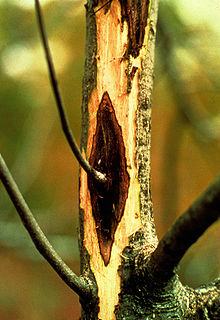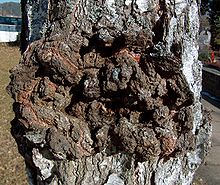Horticulture/Cankers
Canker is a general term for a large number of different plant diseases, characterised by broadly similar symptoms including the appearance of distorted, tumor-like growth and areas of dead tissue, which grow slowly, often over a period of years. Some are of only minor consequence, but others are ultimately lethal, and of major economic importance in agriculture and horticulture. Different cankers and anthracnoses are caused by a wide range of organisms, including fungi, bacteria,phytoplasmas and viruses. The majority of canker-causing organisms are tied obligately to a single host species or genus, but a few will attack a wider range of plants.


Some cankers are treatable with fungicides or bactericides, but many are not; often the only treatment available is to destroy the infected plant to prevent the disease from spreading to other plants.
Bacterial Cankers
edit- Ash bacterial canker, caused by the bacterium Pseudomonas syringae
- Citrus canker, caused by the bacterium Xanthomonas axonopodis
- Poplar canker, caused by the bacterium Xanthomonas populi
Fungal Cankers
edit- Apple canker, caused by the fungi Nectria galligena
- Butternut canker, caused by the fungus Sirococcus clavigigenti-juglandacearum
- Cypress canker, caused by the fungus Seridium cardinale
- Dogwood anthracnose, caused by the fungus Discula destructiva
- Grape canker, caused by the water mold Eutypa lata
- Honey locust canker, caused by the fungus Thyronectria austro-americana
- Mulberry canker, caused by the fungus Gibberella baccata
- Oak canker, caused by the fungus Diplodia quercina
- Pine pitch canker, caused by the fungus Fusarium pini
- Plane anthracnose, caused by the fungus Apiognomonia veneta
- Rapeseed stem canker, caused by the blackleg fungus Leptosphaeria maculans
- Rose cankers, caused by the fungi Leptosphaeria coniothyrium and Cryptosporella umbrina
- Scleroderris canker, caused by the fungus Gremmeniella abietina
- Willow anthracnose, caused by the fungus Marssonina salicicola